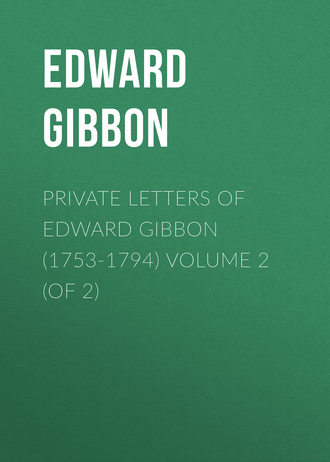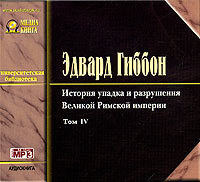 полная версия
полная версияPrivate Letters of Edward Gibbon (1753-1794) Volume 2 (of 2)
He became a barrister, reported in the King's Bench, and was made a K.C. After his marriage he left the Bar for a political career, and held several minor appointments.
128
Brienne retired to Italy in August, 1788, and Necker was recalled in the same month. He at once took steps for summoning the States-General which met at Versailles, May 4, 1789.
129
In the summer of 1788 George III. showed symptoms of mental derangement; but he had signed a warrant for the further prorogation of Parliament from September 25 to November 20. In that interval he grew rapidly worse, and was placed under restraint. The evidence of the king's physicians was laid before the Privy Council and Parliament, and a motion was made in the Lower House for a committee to search for precedents of proceedings in the case of the interruption or suspension of the royal authority. Pitt, on December 16, 1788, moved three resolutions: (1) that the personal exercise of the royal authority was interrupted; (2) that the two Houses have the right to supply this defect of the royal authority; (3) that it was necessary to determine the means by which, during the continuance of the king's incapacity, the royal assent should be given to bills passed by the two Houses. The resolutions were carried in both Houses. The plan of a regency was then submitted to the Prince of Wales, and five resolutions embodying the scheme were proposed and carried in January, 1789. On February 5, 1789, the Regency Bill was introduced in the House of Commons, carried, and sent up to the Lords. It was still under discussion when, on February 19, the Lord Chancellor announced the king's convalescence, and further proceedings were suspended.
130
James, first Earl of Malmesbury, the distinguished diplomatist, married Harriet Mary, daughter of Sir G. Amyand, Bart.
131
George Ellis (1753-1815) is best known for his Specimens of the Early English Poets (1790) and his Specimens of Early English Romances in Metre (1805). He was, wrote Sir Walter Scott, "the first converser I ever saw. His patience and good breeding made me often ashamed of myself, going off at score upon some favourite topic." To him Scott addresses the lines in the fifth canto of Marmion, beginning —
"Thou who canst give to lightest layAn unpedantic moral gay," etc.He had been employed in diplomatic work by Lord Malmesbury at the Hague in 1784, and accompanied him for the same purpose to the Lille Conference in 1797. He was at this time travelling on the Continent with Lord and Lady Malmesbury. The lines on Pitt in Number ii. of the Rolliad are attributed to him —
"Pert without fire, without experience sage,Young, with more art than Shelburne glean'd from age,Too proud from pilfer'd greatness to descend,Too humble not to call Dundas his friend,In solemn dignity and sullen state,This new Octavius rises to debate!" etc., etc.132
De la monarchie Prussienne sous Frédéric le Grand (1788, 4o); and Histoire Secrète de la Cour de Berlin, ou Correspondance d'un voyageur Français (1789, 8o). Both books were by Honoré Gabriel Riquetti, Comte de Mirabeau.
133
His stepmother, Mrs. Gibbon.
134
His aunt, Miss Hester Gibbon.
135
It may be mentioned that Lord Sheffield married, in January, 1798, as his third wife, Lady Anne North, daughter of the Earl of Guilford, and sister of Lady Catherine Douglas.
136
Alluding to Sheffield Place.
137
Sir S. Porten died June 7, 1789.
138
The Comte d'Artois (1757-1836), brother of Louis XVI., and afterwards Charles X., was one of the earliest émigrés.
139
Yolande Martine Gabrielle de Polastron, Duchesse de Polignac (1749-1793), was the most intimate friend of Marie Antoinette. To her and her royal mistress public opinion attributed many of the worst evils of the monarchy. When the daughter of the duchess married the Duc de Guiche (afterwards Duc de Grammont), the king gave the bride a dower of 800,000 livres. "Mille écus," said Mirabeau, "à la famille d'Assas pour avoir sauvé l'État, un million à la famille de Polignac pour l'avoir perdu." (The Chevalier d'Assas lost his life in an heroic action at Klostercamp, October 15-16, 1760. The Government of Louis XV. allowed him to go unrewarded. Louis XVI., at the instigation of Marie Antoinette, conferred on his family a perpetual pension of 1000 livres.) The duchess emigrated with her husband shortly after the taking of the Bastille. She died at Vienna in December, 1793, her death being, it is said, hastened by the murder of Marie Antoinette. Her second son, afterwards Prince de Polignac, was the favourite minister of Charles X.
140
Necker was dismissed July 11, 1789, and ordered to quit the kingdom.
141
Richard Price, D.D. (1723-1791), the celebrated mathematician and economic writer (Observations on Reversionary Payments, Annuities, etc., 1769; Appeal on the Subject of the National Debt, 1772), the opponent of Dr. Priestley (A Free Discussion of the Doctrine of Materialism and Philosophical Necessity, 1778), was also a voluminous political writer, a champion of the cause of American Independence, and an advocate of principles then regarded as revolutionary. His Observations on the Nature of Civil Liberty (1776) procured him an invitation from Congress to come and reside in America. In 1789 he published his Discourse on the Love of our Country, severely criticized by Burke in his Reflections on the Revolution in France. His last work, Britain's Happiness, was published in 1791, the year of his death.
142
The Marquis de Castries (1727-1801), Marshal of France (1783), had served in the Seven Years' War, was Ministre de la Marine 1780-87, and in 1792 held a command in the Prussian army of invasion. He died at Wolfenbuttel in 1801.
143
Adrien Louis de Bonnières, Comte, afterwards Duc, de Guines (1735-1806), had been ambassador in England, 1770-76. As ambassador at Berlin he had been a favourite with Frederick the Great, with whom he played the flute. He emigrated at the beginning of the Revolution.
144
J. Joseph Mounier (1758-1806), the author of Considérations sur le gouvernement qui convient à la France (1789), was a prominent champion of constitutional liberty in the States-General and the National Assembly. He emigrated at the end of 1789.
145
Gérard, Marquis de Lally-Tollendal (1751-1830), the son of the unfortunate governor of the French possessions in India, emigrated after the events of October 5-6, 1789. Returning to France in 1792, he was arrested after August 10, and imprisoned in the Abbaye; he escaped and took refuge in England.
146
Étiennette de Montconseil, daughter of the Marquis de Montconseil, married, in 1766, Charles Alexandre Marc Marcellin d'Alsace-Hénin-Liétard, Prince d'Hénin, brother of the Prince de Chimay and Madame de Cambis, and nephew of the Maréchale de Mirepoix and the Prince de Beauvau. The princess was appointed in 1778 dame du palais in the household of Marie Antoinette. Her intimate relations with Lally-Tollendal were well known. Madame D'Arblay, who knew her well, says of her, twenty years later, that "Lally was her admiring and truly devoted friend, and by many believed to be privately married to her. I am myself of that opinion" (Diary and Letters, vii. 89). The Prince d'Hénin was captain of the body-guard of the Comte d'Artois. He played a conspicuous part in the chronique scandaleuse of the day. His affection for Sophie Arnould gave rise to the following verses of the Marquis de Louvois: —
"Chez la doyenne des catinsTa place est des plus minces.Tu n'es plus le prince d'Hénin,Mais bien le nain des princes."147
Probably Lord Sheffield's portrait, painted by Sir Joshua Reynolds in March, 1788.
148
Major James Rennell (1742-1832) had already published his Maps of Bengal and of the Mogul Empire. His geographical work on Africa and map appeared in 1790.
149
His portrait.
150
At the general election for 1790, Lord Eardley and John Wilmot were returned for Coventry, and the Marquis of Worcester and Lord Sheffield for Bristol. Lord Sheffield sat for Bristol from 1790 to 1802, when he was summoned to the British House of Peers.
151
Lord Sheffield's pamphlet, Observations on the Project for Abolishing the Slave Trade, was published anonymously in 1790. The second edition (1791) bore the author's name.
152
Sir Joseph Banks (1743-1820) sailed with Captain Cook in the Endeavour in 1768. He was President of the Royal Society from 1778 to 1820.
153
In May, 1790, a message from the king was delivered to the House of Commons by Pitt, informing them that two British ships had been seized in Nootka Sound off the coast of California by two Spanish men-of-war, that satisfaction had been demanded, that Spain claimed exclusive rights in those waters, and was making active preparations for war. Spain, relying on the family compact, asked aid from France, and Louis XVI. communicated the demand to the National Assembly, asking that a fleet should be equipped to send assistance. Preparations were made at Brest to send assistance; but the mutinous conduct of the French sailors apparently alarmed the Spanish Government, which withdrew its claims, restored the property seized, and offered compensation. The Convention between England and Spain was signed October 28, 1790. "The first and great news is the pacification with Spain. The courier arrived on Thursday morning with a most acquiescent answer to our ultimatum" (Walpole to the Miss Berrys, November 8, 1790).
154
James Bruce of Kinnaird, F.R.S., published in 1790 his Travels to discover the Sources of the Nile, in five quarto volumes.
155
Origines Guelficæ, quibus potentissimæ gentis primordia, magnitudo, variaque fortuna exhibentur. Opus præeunte G. G. Leibnitii stilo J. G. Eccardi literis consignatum, postea a J. D. Grubero novis probationibus instructum. (Ad finem perduxit atque edidit C. L. Scheidius. Accedit duplex index, etc., curante J. H. Jungio.) Hanoveræ, 1750-80, fol.
156
Decline and Fall of the Roman Empire (edition of 1862), vol. vii. p. 119.
157
"Mr. Gibbon writes that he has seen Necker, and found him still devoured by ambition, and I should think by mortification at the foolish figure he has made" (Walpole to the Miss Berrys, February 28, 1791).
158
Louis Joseph, Prince de Condé (1736-1818), was the son of the Duc de Bourbon who was minister to Louis XV. He had served in the Seven Years' War, and commanded the émigrés on the banks of the Rhine, who were known as the armée de Condé. Both his son and grandson died by violence. His son, the Duc de Bourbon (1756-1830), was found hanged in his room. Suspicion, probably without reason, fell on his mistress, Madame de Feuchéres. With him was extinguished the family of Condé, for the grandson here mentioned was the Duc d'Enghien (1772-1804) who was shot at Vincennes in 1804.
159
Burke's Reflections on the Revolution in France were published in October, 1790. "Gibbon admires Burke to the skies, and even the religious parts, he says" (Walpole to the Miss Berrys, February 28, 1791).
160
The Earl of Guilford (1704-1790) died August 4, 1790, and was succeeded by his eldest son Frederick, better known as Lord North.
161
Lord Sheffield's Observations on the Corn Bill now depending in Parliament was published in 1791. The Corn Regulation Bill was introduced early in that year. The House went into committee on the Bill on February 22, 1791, Lord Sheffield protesting against its principle, but not dividing the House. Lord Sheffield twice beat Pitt (March 11 and April 11) on the question of warehousing foreign corn. He also argued for 52s. instead of 48s. as the lowest price at which, in the interest of farmers, it was possible to admit foreign corn (April 4).
162
Lord Sheffield opposed Wilberforce's motion (April 18, 1791) for the Abolition of the Slave Trade on the ground that the West Indian Assemblies alone could deal with the question fairly in all its bearings.
163
This was probably the debate of May 6, 1791, when Burke declared that, even if loss of friends were the consequence, he would still, with his latest breath, exclaim, "Fly from the French Constitution!" "There is no loss of friends," said Fox. "Yes, there is," retorted Burke. "I know the price of my conduct! I have indeed made a great sacrifice: I have done my duty, though I have lost my friend." Burke's speech was made on the Quebec Bill, and Lord Sheffield moved, and was supported by Fox, that dissertations on the French Constitution were not pertinent to the question before the House. Fox's panegyric on the French Revolution, to which Burke's speech was a reply, was delivered on the treaty between Russia and the Porte.
164
In the spring of 1791 war with Russia seemed probable. Catharine had in the preceding year concluded peace with Sweden, and the winter campaign of 1790-91 placed the Ottoman Porte at her mercy. Great Britain endeavoured to secure favourable terms for Turkey, and made active preparations to enforce her efforts. The king's message to the House of Commons (March 28, 1791) asked for an increase to the navy in order to bring pressure to bear on Russia. But Great Britain was without allies. Prussia was irresolute, Sweden exhausted, Denmark unwilling to quarrel with Russia, Austria intent on recovering the Austrian Netherlands. Her protest was, however, not without effect. Catharine refused to recognize Great Britain as a mediator or to recede from her demands. But she made peace with Turkey at Galacz in August, 1791, restoring all her conquests except Otchakov and the surrounding territory between the Bug and the Dniester. The strong opposition to war with Russia doubtless influenced Pitt. But it is said that the opinion of the Dutch Admiral, Kingsbergen, that Sebastopol, not Otchakov, was the real danger to Turkey, finally changed his view. The Duke of Leeds resigned the Secretaryship of State on the question, and was succeeded by H. Dundas.
165
Probably his treatise De l'administration de M. Necker, par lui-même.
166
The words in the original letter are torn out by the seal.
167
Jacques Marie de Cazalès (1752-1805), whom Madame Roland called, for his ability, the "astonishing" Cazalès, was an eloquent defender of the Monarchy. Suspected of conniving at the king's escape from Paris in June, 1791, he was arrested, and was possibly in prison at the time when Gibbon's letter reached Lord Sheffield. After the capture of Louis XVI. at Varennes, he left France, and, as an émigré, took part in the campaign of 1792.
168
The Abbé Maury (1746-1817), one of the supporters of the Church and the Monarchy in the States-General, left France in September, 1791, after the dissolution of the Constituent Assembly. Made by Napoleon Archbishop of Paris (1810-14), he was deprived of episcopal authority by the Pope, who had previously given him a cardinal's hat. At the fall of the Empire he was summoned to Rome, and confined for some months in the Castle of St. Angelo.
169
On Saturday, June 25, news reached London that Louis XVI., his wife and children, had on the previous Tuesday escaped from Paris. They travelled with a passport made out for the Baroness de Korff, obtained at the request of M. Simolin, the Russian Ambassador, who was ignorant of the use to which it was to be put. The king intended to reach Montmédy, and there place himself under the protection of the Marquis de Bouillé, who commanded the army of the Meuse and Moselle. At Ste. Menehould the fugitives were recognized by the Postmaster Drouet, arrested at Varennes, and brought back to Paris.
170
The ambassador at Paris.
171
On June 26, 1791, a plan was presented to the National Assembly for the prosecution of the king and of those who assisted him in his escape. After a warm debate, commissioners were nominated to inquire into the events of June 20-21, and three commissioners were separately appointed to take the signed declarations of the king and queen. The proposal to distinguish the case of the king and queen from that of inferior persons was unsuccessfully opposed by Robespierre.
172
The three Gardes du Corps, brought back on the top of the royal carriage, bound with ropes, were MM. de Valery, de Moustier, and de Malden. The two former published accounts of the flight to Varennes.
173
François Claude Aymour, Marquis de Bouillé (1739-1800), born at the Château de Cluzel in Auvergne, died at London in 1800. He had distinguished himself both in the Seven Years' War and in the American War of Independence. In 1790 he became governor of the provinces of les Trois Évêchés, Alsace, Lorraine, and Franche Comté, and commander-in-chief of the army of the Meuse, Sarre-et-Moselle, with his head-quarters at Metz. His letter to the National Assembly was written, as he states, to divert the wrath of the Assembly from the king to himself. In it he assumed the whole responsibility for the affair. His letter, says M. Feuillet de Conches (Louis XVI., Marie Antoinette et Madame Elisabeth, vol. iv. pp. 469-471), produced a deep impression throughout Europe. Three autograph letters, addressed by Louis XVI., and the Kings of Sweden and Prussia, to the marquis, are there quoted. After the arrest of Louis XVI. at Varennes he fled to Coblentz, summoning officers and men to join him. He served in the army of the Prince of Condé in 1791, and in that of the Duke of York in 1793. He afterwards retired to England, where his Mémoires sur la Révolution were published in 1797.
174
Elizabeth Vassall, a West Indian heiress, married, May 27, 1786, Sir Godfrey Webster, Bart., of Battle Abbey, Sussex. She was divorced from her husband on July 3, 1797, and, three days afterwards, married the third Lord Holland.
175
François Choderlos de Laclos (1741-1803), novelist, poet, and soldier, was at this time editor of the Journal des amis de la Constitution. He helped Brissot to draw up the petition for the deposition of Louis XVI., July 17, 1791.
176
Voltaire died at Paris in May, 1778. His body, lest burial should be refused, was carried to the Abbey of Scellières. Thence the remains were brought, Sunday, July 10, 1791, to the ruins of the Bastille, and placed the next day in the Pantheon.
177
On Wednesday, July 13, 1791, the report of the seven committees on the affairs of the king was read before the National Assembly, detailing the circumstances of the king's escape, and stating the manner in which, by the laws of the Constitution, the Assembly should conduct itself towards the king. Practically, the report was in favour of the inviolability of the king's person. In this sense it was adopted on July 15, 1791, and against it was held the meeting of the Champs de Mars on July 17.
178
J. Pierre Brissot (de Warville) (1754-93) was at this time a supporter of the Duc d'Orléans. He afterwards led the Brissotins against the Montagnards, and was guillotined with the Girondists in October, 1793.
179
On the Island of St. Pierre, in the Lake of Bienne, J. J. Rousseau lived in 1765.
180
After the meeting of the Emperor of Austria and the King of Prussia at Pilnitz, Coblentz became the rallying-point of the émigrés– "a small extra-national Versailles: a Versailles in partibus."
181
The family of Guiche were descended from la belle Corisande, who, left a widow at twenty-six by the death of her husband, the Comte de Guiche, became the mistress of Henry IV., then only King of Navarre. The Duc de Guiche (afterwards Duc de Grammont) married, in 1779, a daughter of the Duchesse de Polignac, and to her interest he owed his place as captain of the Villeroy Company of the Gardes du Corps. He was also colonel of the Dragons de la Reine. The duke is a "good-natured young man" (Lord Auckland's Journal and Correspondence, vol. i. p. 412).
182
Charles Theodore, Elector of Bavaria and of the Palatinate.
183
Monsieur, the title given to the eldest brother of the reigning King of France, was the Comte de Provence, afterwards Louis XVIII. (1755-1824). Madame, his wife, was Maria Josephine Louisa, daughter of Victor Amadeus III. of Sardinia. They escaped from Paris on the same night as Louis XVI.
184
The Prince of Nassau-Siegen sailed round the world with Bougainville (1766-69), served in the Spanish army at the siege of Gibraltar, then entered the service of the Empress Catharine, and, as an admiral, commanded the Russian fleet against Turkey and afterwards against Sweden.
185
Count Nicholas Romanzov, son of the distinguished Russian general.
186
Marc Hilaire de Conzie (1732-1805), Bishop of St. Omer, became, in 1769, Bishop of Arras. With his brother, who succeeded him as Bishop of St. Omer, he administered the province of Artois. He followed the Comte d'Artois in his flight to Italy, and at London was afterwards his chief political adviser. He was a friend of Madame du Deffand, who writes of him enthusiastically. The Duc de Lévis (Souvenirs et portraits) speaks of him less favourably: "Il ne fit que du mal à son parti."
187
The Baron de Luckner (1722-1794), a Bavarian, entered the French service after the Seven Years' War, was made a marshal in 1791, and guillotined in 1794.
188
The Duc de Broglie (1718-1804), one of the most distinguished of the French generals during the Seven Years' War, was made a marshal in 1759. Louis XVI. appointed him in 1789 Minister of War; but he was among the earliest of the émigrés. He entered the Russian service in 1794.
189
In August, 1790, the Swiss Regiment of Château-Vieux mutinied at Metz, demanding arrears of pay. They fired upon the National Guard, seized the regimental treasury, and killed Desilles. The outbreak was quelled by Bouillé. Of the survivors of the Regiment of Château-Vieux, twenty-three were hanged, and forty-one sent to the galleys. These galley-slaves were subsequently released; a fête in their honour was decreed by the Assembly; their chains hung up as trophies in the Jacobin Club at Brest, and the men carried through Paris in triumph on April 15, 1792.
190
The meeting of the King Frederick William of Prussia and the Emperor Leopold of Austria at Pilnitz in 1791, excited the greatest interest in Europe. It was supposed at the time that the second partition of Poland was there concerted. But no definite declaration in common seems to have been signed at that time by the two sovereigns, except an engagement to make certain representations to the French Government as to Louis XVI., the Monarchy, and the restoration of property to the émigrés, and to invite an European concert for the purpose of enforcing these representations.









